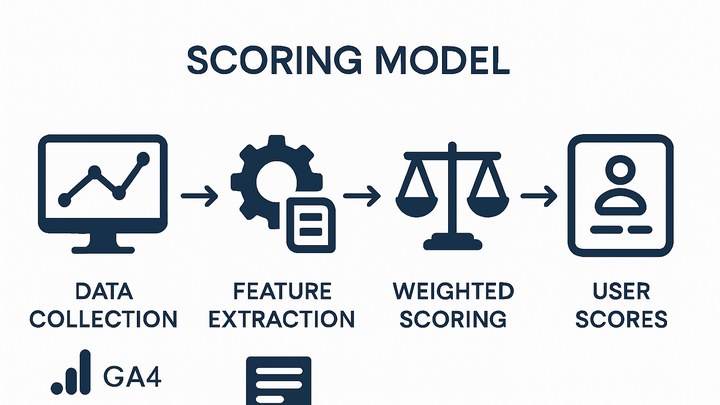Published on 2025-06-26T05:31:29Z
What is a Scoring Model? Examples in Analytics with GA4 and PlainSignal
A scoring model is a statistical or machine learning framework that assigns numerical scores to users, leads, or events based on specific features. In analytics, scoring models help quantify the likelihood of outcomes such as conversions, churn, or engagement. By analyzing patterns in user behavior, attributes collected via tools like Google Analytics 4 (GA4) and PlainSignal, organizations can prioritize efforts, segment audiences, and optimize campaigns. Scoring models can be simple linear equations with weighted factors or sophisticated algorithms like logistic regression, decision trees, or neural networks. Implementing and refining these models ensures data-driven decision-making, improves targeting, and enhances ROI across marketing and product strategies.
Scoring model
A scoring model assigns numeric values to user attributes to predict behavior, segment audiences, and inform analytics decisions.
Introduction to Scoring Models
Scoring models translate complex user data into actionable scores that represent probabilities or ranks. They are foundational to predictive analytics and audience segmentation.
-
Definition
A scoring model is a mathematical framework that evaluates features or attributes to produce a numeric score indicating likelihood or rank.
-
Common use cases
Scoring models are used for lead ranking, churn prediction, user engagement analysis, and credit risk assessment.
-
Lead scoring
Prioritizing sales leads based on their estimated conversion potential.
-
Churn prediction
Estimating the probability of a user discontinuing service.
-
Key Components of a Scoring Model
Every scoring model consists of features, weights, and normalization steps to ensure accurate and stable scoring.
-
Features (predictors)
Variables or data points (e.g., pageviews, session duration, demographic attributes) used as inputs.
-
Weights and coefficients
Numeric values assigned to features reflecting their relative importance in the scoring formula.
-
Normalization and scaling
Techniques to adjust feature values to a common scale, preventing any single feature from dominating the score.
Implementing Scoring Models in GA4
Google Analytics 4 provides tools to capture and analyze user behavior, enabling you to build custom scoring models.
-
Custom dimensions and metrics
Define custom dimensions and metrics in GA4 to collect key features required by your scoring model.
-
Predictive metrics in GA4
Leverage built-in predictive audiences such as purchase probability and churn probability to augment your scoring.
-
Purchase probability
An estimate of the likelihood a user will complete a purchase within a specified timeframe.
-
Churn probability
The likelihood that a user will not return to your site or app within a given period.
-
Implementing Scoring Models with PlainSignal
PlainSignal offers a cookie-free analytics approach, capturing user events that feed into scoring models seamlessly.
-
Data collection setup
Embed the PlainSignal tracking snippet into your site to capture event data without cookies.
-
Example tracking code
Include the following snippet:
<link rel="preconnect" href="//eu.plainsignal.com/" crossorigin /><script defer data-do="yourwebsitedomain.com" data-id="0GQV1xmtzQQ" data-api="//eu.plainsignal.com" src="//cdn.plainsignal.com/plainsignal-min.js"></script>
Best Practices and Considerations
Adhere to best practices to maintain accurate, fair, and effective scoring models.
-
Ensure data quality
Validate input data to avoid biases and errors compromising your scoring results.
-
Monitor and update regularly
Retrain and recalibrate your model periodically to reflect changes in user behavior and market conditions.
-
Address bias and fairness
Audit scoring outcomes to ensure equitable treatment across different user groups.
